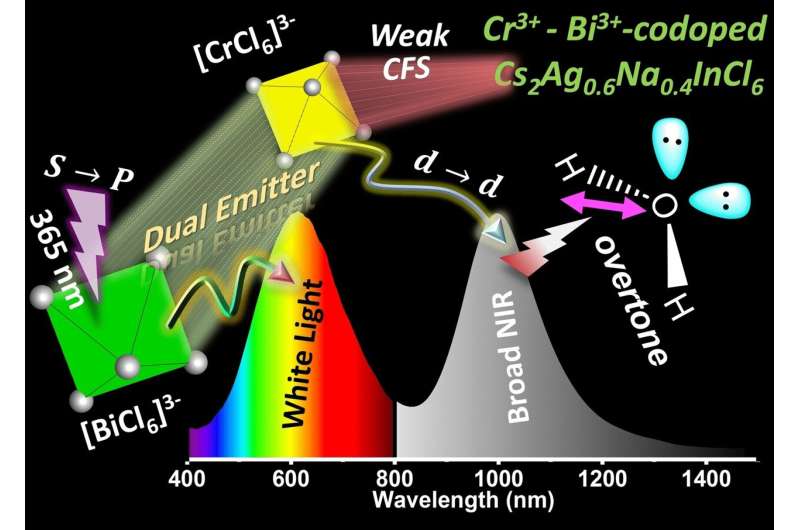This article has been reviewed according to Science X's editorial process and policies. Editors have highlighted the following attributes while ensuring the content's credibility:
fact-checked
peer-reviewed publication
trusted source
proofread
Perovskite-modified LEDs reveal rot in spoiled food before it is visible

A team of researchers has developed new LEDs which emit light simultaneously in two different wavelength ranges, for a simpler and more comprehensive way to monitor the freshness of fruit and vegetables. As the team write in the journal Angewandte Chemie International Edition, modifying the LEDs with perovskite materials causes them to emit in both the near-infrared range and the visible range, a significant development in the contact-free monitoring of food.
Perovskite crystals are able to capture and convert light. Being simple to produce and highly efficient, perovskites are already used in solar cells but are also being intensively researched for suitability in other technologies. Angshuman Nag and his team at the Indian Institute of Science Education and Research (IISER) in Pune, India, are now proposing a perovskite application in LED technology that could simplify the quality control of fresh fruit and vegetables.
Without light converters, LEDs would emit light in rather narrow light bands. To cover the whole range of white light produced by the sun, the diodes in "phosphor-converted" (pc) LEDs are coated with luminescent substances. Nag and his team have used a double emission coating with the purpose to produce pc-LEDs that emit both white ("normal") light and also a strong band in the near-infrared range (NIR).
To make the dual-emission pc-LED, they applied a double perovskite doped with bismuth and chromium. Part of the bismuth component emits warm white light and another part transfers energy to the chromium component, de-exciting it and causing an additional emission in the NIR range, the researchers found out.
NIR is already used in the food industry to examine freshness in fruit and vegetables. Nag and Ph.D. student Sajid Saikia, first author of the paper, explain their idea. "Food contains water, which absorbs the broad near-infrared emission at around 1,000 nm. The more water that is present [due to rotting], the greater the absorption of near-infrared radiation, yielding darker contrast in an image taken under near-infrared radiation. This easy, non-invasive imaging process can estimate the water content in different parts of food, assessing its freshness."
Using these modified pc-LEDs to examine apples or strawberries, the team observed dark spots that were not visible in standard camera images. Illuminating the food with both white and NIR light revealed normal coloring that could be seen by the naked eye, as well as those parts which were starting to rot, but not yet visibly so.
Saikia and Nag envision a compact device for simultaneous visual and NIR food inspection, although the two detectors, one for visible light and one for NIR light, could make such an instrument costly for common applications. On the other hand, the researchers emphasize that the pc LEDs are easy to produce without any chemical waste or solvents and short-term costs could be more than recovered by the long service life and scalability of this novel dual-emitting pc-LED device.
More information: Sajid Saikia et al, Broad Dual Emission by Codoping Cr3+ (d -> d) and Bi3+ (s ->p) in Cs2Ag0.6Na0.4InCl6 Double Perovskite, Angewandte Chemie International Edition (2023). DOI: 10.1002/anie.202307689
Journal information: Angewandte Chemie International Edition
Provided by Wiley





















